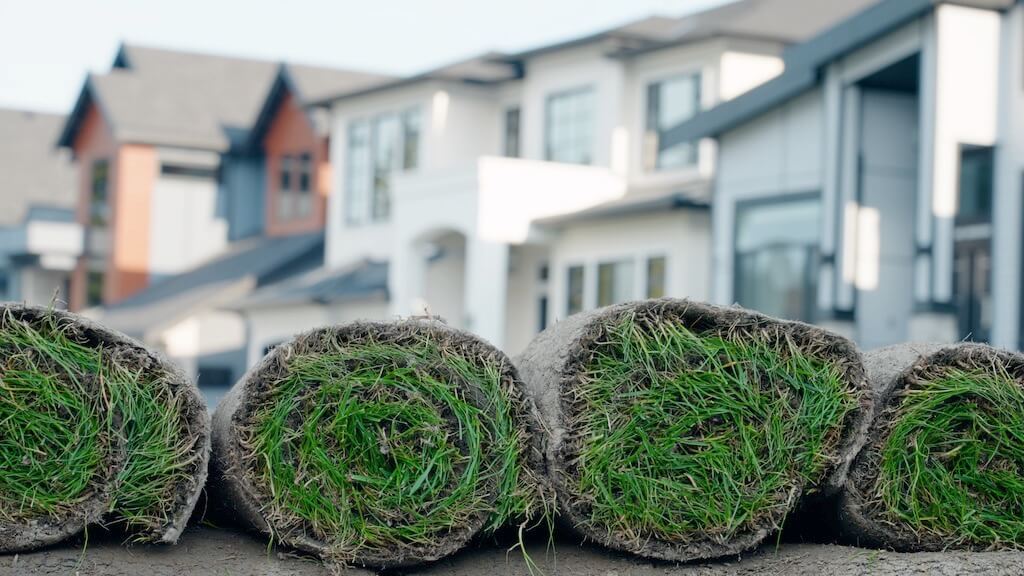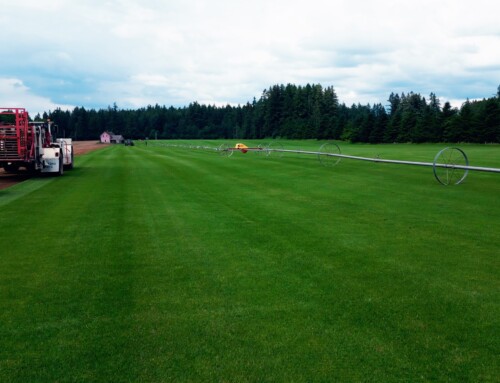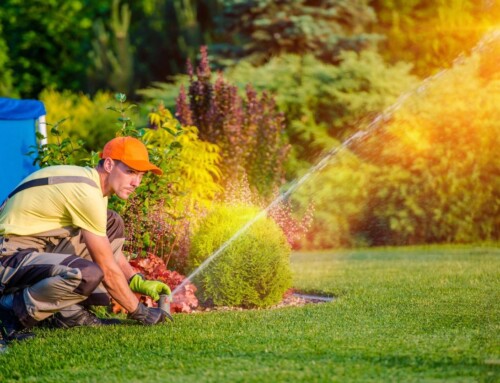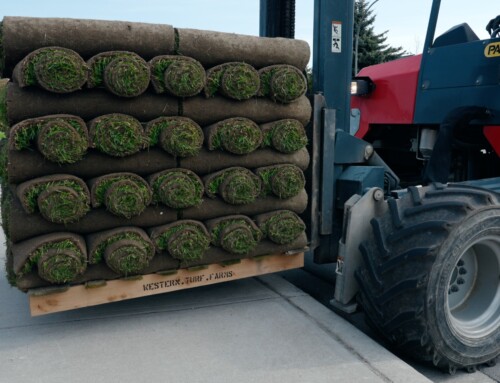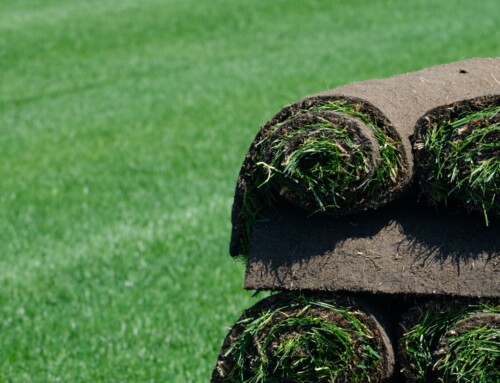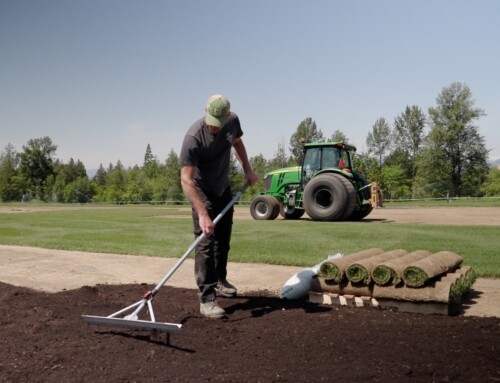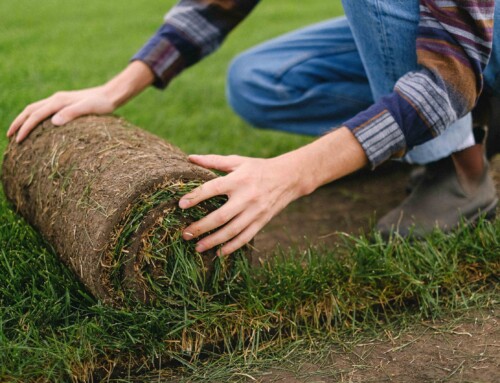When thinking about your dream home, one of the things that comes immediately to mind for many homeowners is a lush, healthy, green lawn. Even in your existing home, transforming your lawn into a green paradise can have a stunning effect, rejuvenating your property.
Whether you are a beginner or an experienced lawn enthusiast, this guide is intended to provide you with the information you need to make informed decisions about selecting and maintaining the best residential turf in Canada.
Understanding Turf Basics: Getting Started
To choose the best turf for your property, you should understand what it is and how to choose the right kind.
What is Turf? A Quick Introduction
In simple terms, turf is like a carpet on your outdoor spaces. It refers to not only the grass, but also the soil layer that covers the ground. While many homeowners focus on the aesthetic appeal of a healthy lawn, it does more than simply beautify your home. Grass is a type of plant and so, like any other plant, it helps to purify the air by taking in CO2 and producing oxygen. Additionally, turf absorbs rainfall and helps to prevent soil erosion, making it not only beautiful, but highly beneficial.
Benefits of Choosing the Right Turf
While some might argue that there isn’t really a wrong type of turf, choosing the best type for your location and environment, as well as the needs of your property, will provide you with far superior results. Will your lawn be purely ornamental? Will it need to endure foot traffic, pets, and other stresses?
Choosing the right turf for your property gives you a beautiful lawn that enhances curb appeal and offers a superior environment for relaxation and recreation. When you make the right choice, you contribute to both aesthetics and functionality.
Factors to Consider When Choosing Residential Turf
To help you select the right type of grass, let’s review some of the factors you need to consider, including your soil type, climate, and the amount of maintenance your sod will require.
Soil Type and Quality in Your Region
While some may assume that all soil is the same, there are different types and different qualities, and this will affect the success of your turf. Before selecting your turf, conduct a soil test. This will help you understand its pH and nutrient content and give you insight into its drainage capacity. Different types of grass have their own conditions in which they thrive or struggle. For example, if you have sandy soil, your ideal turf will differ from those who have clay soils. When you match the correct turf to your soil type, you will have greater success, healthier growth, and easier maintenance.
Climate and Weather Patterns: Warm or Cool Season Grass?
Along with soil type, climate is one of the more significant factors that you need to consider. Varieties of grass fall into two broad categories: cool-season grasses like Kentucky Bluegrass will thrive in cooler climates, but for warmer weather you will want warm-season grasses like Bermuda grass. When selecting your turf, consider the average temperature for your region, as well as the amount of sunlight exposure and rainfall patterns. This will ensure that you choose the turf that can thrive on your property.
Maintenance: How Hands-on Do You Want to Be?
Some homeowners enjoy every facet of lawncare and general home maintenance. Others may look upon those things as pure chore and want to provide the minimum amount of maintenance while achieving the best results possible.
Some grasses require frequent mowing, along with fertilization and comparatively heavy irrigation. If you are not interested in that, or are unable to devote much time to lawncare, then you are better served by choosing grasses that have lower maintenance needs. Some varieties require minimal intervention while still offering you an attractive lawn.
Delving into Grass Types
Now that you have a good idea of your soil type, your climate and rainfall, and the amount of work you are prepared to invest in your lawn, it’s time to look at some of the different varieties of grass that you may choose from in this turf selection guide.
Kentucky Bluegrass: Classic Beauty and Resilience
Kentucky Bluegrass is a popular choice, often viewed as the basis for the perfect lawn. With an emerald-green appearance, it is a grass that is well-suited to cooler climates and in its ideal environment, it produces a lawn that is lush and durable. It is slow to establish, but once it does, it is dense and attractive, able to stand up well to foot traffic.
Kentucky Bluegrass has its best growth during the spring and summer, and It has excellent winter hardiness. This makes it an superb choice in northern climates from coast to coast. It does require a moderately high level of maintenance to be its best, but many will find the results worthwhile.
Perennial Ryegrass: Fast Establishment and Wear Resistance
Perennial Ryegrass is well-known for a fast germination rate and ability to establish quickly. It endures shade well and is drought tolerant. It grows quickly and can tolerate close mowing and it is often blended with other grasses, adding greater durability. This is useful for lawns that undergo heavy use. It also has a deep rooting system that helps to break up the soil, providing aeration.
On the negative side, the rapid growth of Ryegrass requires more frequent mowing. It is also susceptible to disease, particularly fungi, and requires a good amount of fertilizer.
Fescue Varieties: Drought Tolerance and Shade Affinity
There are many varieties of fescue, making them well suited to several different growing environments. Tall Fescue has a finer texture than traditional grasses. It grows best in heavier soils and has better heat tolerance than many cool-season grasses. It is also more cold-resistant than many warm-weather grasses, making it a good grass for transition zones between temperature extremes. It is best suited, however, for northern lawns, where it grows best in spring and fall. It is a good choice where drought resistance is required.
Another variety, Creeping Red Fescue, is a variety of Fine Fescue that enjoys the shade and performs best when combined in a seed blend with other cool-season grasses. It is sometimes used in areas of the lawn where other types of grass are struggling.
Turf Installation and Care Tips
While certain varieties of turf are better able to deal with specific environments, they only reach their full potential when maintained properly, even if they only require minimal care. Here are some lawn care tips for Canadian homes:
The Right Time for Turf Installation
The best time to install turf varies by the type of grass and your local climate. When installing cool-season grasses, fall is recommended. This will allow them to establish their roots before the onset of winter. If you are installing warm-season grasses, then do so in late spring or early summer. The warm weather will encourage quicker growth.
Initial Care: Watering, Mowing, and Nurturing
Following the installation of your new turf, you need to follow up with the appropriate care. This means adequate irrigation, regular mowing, and fertilization. Abundant water is required to help your new lawn survive because until it can establish good roots in your soil, it will struggle to find enough water to support itself. Never allow the soil underneath to dry out, watering twice a day in hot weather.
When mowing, adjust the height to suit the variety of grass that you have chosen and be sure to provide your new lawn with adequate nutrients to help it grow and remain healthy.
Seasonal Tips for Evergreen Beauty
Lawn care must be tailored to your specific situation. Not only are you accounting for the type of grass and soil, but also for the changing seasons. In spring, start with a quick clean up, raking out dead grass, sticks, and other debris. Mow high to encourage the grass to grow thicker, with deeper roots. This can help to crowd out weeds. As your grass starts to green up, patch any bare spots.
During the warmer months, you will need to mow more often as the grass will be growing faster. Continue mowing high to encourage the development of the roots. Make sure your mower blades are sharp, as a nice, clean cut helps reduce moisture loss. You may also be contending with weeds and will need to water your lawn more frequently during dry spells.
When the cooler months arrive, you won’t have to mow as often, but will need to fertilize to strengthen your turf’s roots. Mow short, 1 to 2 inches shorter than usual. If you have falling leaves, this will prevent them from matting down the grass.
FAQ
Here are some common questions regarding turf for your property.
What’s the Best Turf for Shaded Residential Areas?
Fescue grass varieties, such as Tall Fescue and Fine Fescue are great choices for your shaded areas, as they are adaptable and shade tolerant.
How Often Should I Water My New Turf?
New turf requires regular watering to keep the soil moist, but not to the point of over watering. Water more frequently but for shorter durations when experiencing a dry spell. Gradually reduce the frequency of waterings and increase the volume of water as the roots establish themselves.
Can I Install Turf During Any Season?
Turf should be installed according to its best growth period. This means early fall for cool-season grasses and late spring or early summer for warm-weather grasses.
What’s the Difference Between Cool and Warm Season Grasses?
As implied by the names, cool-season grasses prefer cooler temperatures, in which they thrive. Warm-season grasses do best in warmer climates. This is why it’s important to choose the right grass for your region.
How Can I Ensure that My Turf Stays Green and Lush Throughout the Year?
Your lawn should remain healthy and lush throughout the year if you follow proper seasonal care, mowing at the right height, watering as necessary, fertilizing to provide necessary nutrients, and providing basic regular maintenance.
Premium grass choices for homes deserve the best care. With some maintenance and the best Western Turf Farms products, you will have a beautiful lawn, where your kids can run and play, and you can relax in the shade.
Embark on your journey to a greener home with Western Turf Farms. Get expert guidance and premium turf products now! For more information about obtaining the perfect lawn, contact us today!

